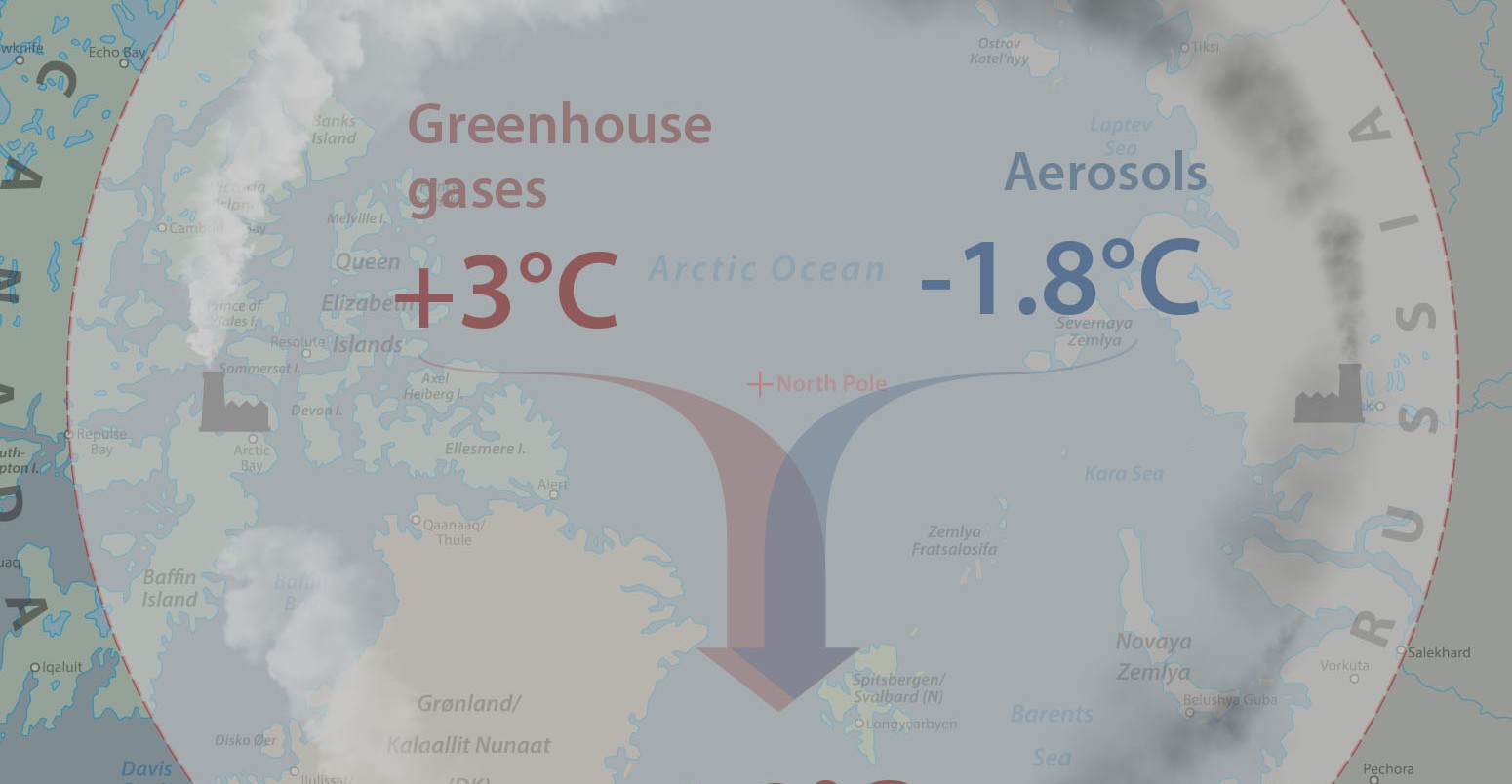
Aerosols dampen pace of Arctic warming for now, say scientists
Robert McSweeney
02.11.15Robert McSweeney
11.02.2015 | 11:00amAs the Earth warms under increasing greenhouse gas emissions, temperatures have risen more quickly in the Arctic than the rest of the world. But particles emitted as fossil fuels are burned mask a lot of that warming. Without them, the temperature rise in the Arctic would be more than double what we’ve seen in the past century, a new study finds.
But it’s no good news story, those same particles are responsible for causing air pollution in cities across the world.
And with air pollution set to fall while greenhouse gases continue to rise, we could soon see a faster rate of warming in the Arctic, the lead author tells Carbon Brief.
Twice as fast
Temperatures in the Arctic are increasing more than twice as fast as the global average. This is known as Arctic amplification. A primary cause is diminishing Arctic sea ice: as the ice melts, energy from the sun that would have been reflected away is instead absorbed by the ocean.
A new study, just published in Nature Climate Change, works out the specific contributions from different influences on temperatures in the Arctic, including natural factors.
Humans can affect the climate in contrasting ways. The planet warms as extra greenhouse gases in the atmosphere trap more heat. But at the same time, other tiny particles and gases known as aerosols are having an overall cooling effect.
The particles have a direct effect on temperature by scattering sunlight, and an indirect effect by stimulating clouds to form, preventing sunlight reaching Earth’s surface.
Some sources of aerosols are natural, such as volcanoes and chemicals released by tiny sea creatures. However, since the industrial revolution, humans have been emitting more and more aerosols through vehicle exhausts and burning fossil fuels and wood.
Fingerprints
The research compares three influences on global temperature: human-caused greenhouse gas emissions, human-caused aerosol emissions, and natural climatic variations.
The study looks at surface temperature changes in the Arctic from 1913 to 2012. Comparing historical temperature observations with climate model simulations, the researchers work out the ‘fingerprint’ of each influence on past temperature changes.
The results show greenhouse gas warming alone would amount to around three degrees Celsius in the Arctic over the last 100 years. But actual observed warming is around 1.2 degrees Celsius. So why the shortfall?
It turns out that the difference is caused by the aerosols emitted alongside greenhouse gases. Aerosols offset about 60 per cent of the warming, causing temperatures to be 1.8 degrees lower than they would otherwise be.
By comparison, natural climatic changes have no discernable impact on long-term warming, the paper finds.
The warming and cooling influences of human activity. Credit: Rosamund Pearce, Carbon Brief
Rate of warming
Aerosols have prevented the Arctic from warming as much as it would had greenhouse gases been acting on their own, says lead author Dr. Mohammad Reza Najafi from the University of Victoria in Canada.
And the results suggest the cooling effect from aerosols is much larger in the Arctic than elsewhere in the world, Najafi adds. A separate study finds aerosols were responsible for offsetting around five per cent of global greenhouse gas warming between 1901 and 2010, and around 27 per cent for the shorter period of 1951 to 2010.
In the coming decades, human-caused emissions of aerosols are projected to decrease, but greenhouse gases are expected to continue to rise. This could mean the rate of Arctic warming increases, says Najafi:
“Projections based on climate model simulations using a high emission scenario suggest that Arctic temperatures might rise by 8.3 degrees by the end of the century.”
The new research shows that while aerosols are offsetting some warming in the remote North, it’s unlikely to stay that way. We’re seeing changes in the Arctic already and picking up the pace of warming is likely to have serious implications for wildlife and even Northern Hemisphere weather.
Main image: Graphic preview: Aerosols in the Arctic.
Najafi, M.R., et al. (2015) Attribution of Arctic temperature change to greenhouse-gas and aerosol influences, Nature Climate Change, doi:10.1038/nclimate2524


